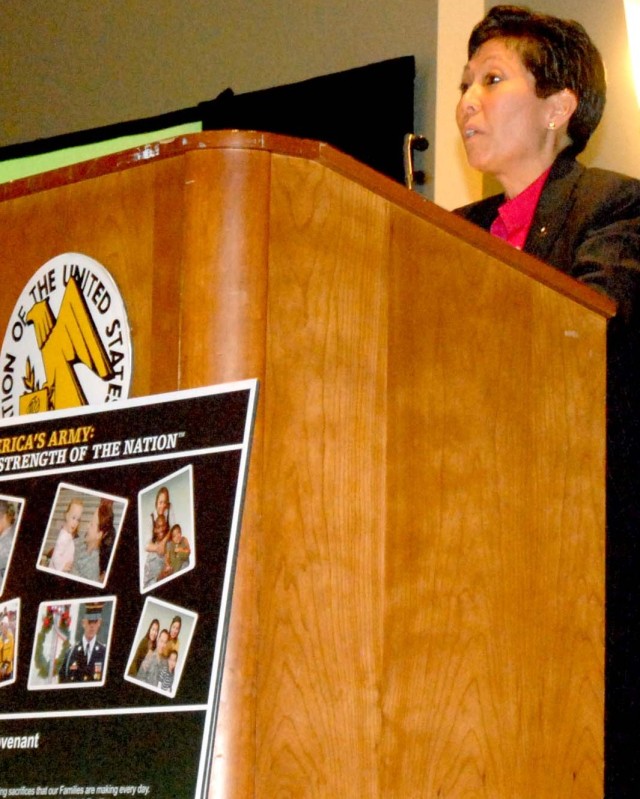
WASHINGTON, D.C. - U.S. Army Forces Command Family Readiness Group (FRG) leaders heard Dr. Lynn Heirakuji, Deputy Assistant Secretary of the Army for Personnel Oversight, share results of an Army-wide study about geographically dispersed Soldiers and Family members Oct. 5, during the Association of the U.S. Army Family Forum here.
The 450 company-level FRG leaders from installations across the country are in the nation's capital to attend the second annual FORSCOM FRG Training Symposium at the Hyatt Crystal City Hotel. This annual training event was scheduled the same week as the annual AUSA National Meeting and Expo to allow FORSCOM's FRG leaders to take advantage of AUSA's Family Forums and to see the exhibits at AUSA in addition to the full agenda prepared for them by FORSCOM's G1 Well Being Division.
Heirakuji said the Army's Geographically Dispersed Task Force (GDTF) conducted two strategic working groups, during February and August, with about 6,000 of its key stakeholders, Soldiers and Family members. The purpose of the study was to gage the perceptions of those Soldiers and Family members, learning about their awareness, their accessibility and their use of 32 Army-sponsored services designed to improve the Well Being of Army Families. The study consisted of input from Reserve Component Soldiers and Family members who have dispersed in communities across America.
The task force set out to answer the question, "How can the Army provide comprehensive and equitable support services to meet the diverse needs of Soldiers and Family Members, regardless of their location or component'" Heirakuji said.
"It became clear to us that we, the Army, needed to know more about how geographically dispersed Soldiers and Families were being supported," she said. "We recognized that to fulfill the commitment of the Army Family Covenant and Army Community Covenant, we needed to understand the impact of geographical dispersion on Families."
Among those who participated in the task force's sensing sessions, assessment surveys and interviews were a significant number of National Guard, Reserve and Active Component (recruiters) Soldiers and Family members.
"We intuitively understood that geographic dispersion creates challenges, but we did not know the degree (of the challenges) and how the geographic dispersion affected knowledge of, access to, and use of services," she said. "The task force is an example of what we are trying to achieve to help the covenant's commitment to deliver programs that are commensurate with the service of all Soldiers and all Families, including those not near or on an installation."
An Army Reserve Soldier said the distance from the nearest Army installation affects her knowledge and use of Army sponsored services, such as health and medical services; Family readiness groups; Family assistance centers; child, youth and school services; reintegration activities, financial and legal assistance and employment assistance.
Staff Sgt. KaRonda Fleming, a Reservist assigned to the 210th Mobile Public Affairs Detachment in Garner, N.C., said distance is definitely a factor in her awareness, accessibility and use of Army sponsored services.
"I live in Greenville, N.C., which is approximately an hour and 15 minutes from my unit, and it is also an hour and 30 minutes from Fort Bragg, N.C. (the nearest Army installation)," Fleming said.
When she's not on Reserve status, Fleming explained that she works for a pharmaceutical company, conducting training classes. Her eight-to-five civilian work schedule often makes it impossible to use services offered at Fort Bragg.
"I would utilize the health services at Fort Bragg if they were in driving distance," Fleming said.
Ultimately, Fleming said she knows about the basic services, such as medical and legal, afforded to military members, but she is sure there are others she doesn't know about. As a result, Flemming said she has become used to using local, non-military services.
GDTF findings indicate military Web sites are the most popular source for information among geographically dispersed Soldiers and their Family members. However, results also indicate the numerous Web sites are overwhelming for information seekers and not very user friendly. Therefore, most of the participants in the study still prefer face-to-face contact with subject matter experts to get information, said Heurakuji.
When asked whether they were informed about services, 81 percent of surveyed Soldiers and Family members who have attended reintegration events responded positively. Of the group who had not attended reintegration events, 62 percent responded positively, according to GDTF findings.
The results of the GDTF study validate that the Army offers a range of quality services to meet the needs of geographically dispersed Soldiers and Family members, Heirakuji said.
Conversely, the study also yielded findings that indicate the Army must ensure an adequate structure and delivery mechanisms for information about available services, she said.
The GDTF submitted recommendation, pertaining to the study to the Assistant Secretary of the Army Manpower and Reserve Affairs Sept. 30. Currently, the Army will continue to support the Office of the Secretary of Defense's efforts in this matter and continue to assess the Army Family Covenant program, said Heurakuji.

Social Sharing